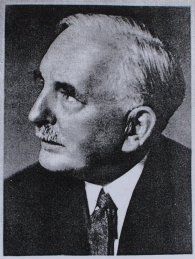Ewald Sträßer
Ewald Sträßer was born on 27 June 1867 in Burscheid (Germany). His father is an enthusiastic music lover and amateur musician, singer and composer. The father is member of the local orchestra association, an ensemble of ambitious amateur musicians. For that reason Ewald Sträßer came in touch with music from an early age. He first received piano lessons by his father, later by H. Hofmann, the conductor of the Burscheid orchestra association. From the age of 10 Ewald Sträßer studied violin, composition and music theory under August Lenzen, a former student of Joseph Joachim. In 1883 he moved to Cologne to study music at the conservatory. Among his teachers was Franz Wüllner.
After his studies Ewald Sträßer first worked as a composer in Burscheid, but returned to Cologne in 1892 to lecture harmonics and counterpoint at the conservatory. His most notable students of this time are Erwin Schulhoff and Hans Knappertsbusch. His breakthrough as a composer came in 1909 when his first symphony op.22 was premiered under the conductor Fritz Steinbach in Cologne. In the next decade Sträßer's compositions are widely performed by numerous renowned musicians. For example by conductors like Nikisch, Richard Strauß, Furtwängler or Hausegger as well as the Rose Quartet, Gürzenich Quartet, Elly Ney (piano) or Bram Eldering (violin). His success culminated in the title "Royal Professor" which was awared to him by the German emperor in 1917. In 1921 Ewald Sträßer moved to Stuttgart where he taught a master class in composition (as successor of Joseph Haas) until his retirement in 1932. Already a year later Eward Sträßer died on 4 April 1933 in Stuttgart (Germany).
The work catalogue of Ewald Sträßer contains more than 200 compositions, among them 8 symphonies, 4 violin concertos, 2 cello concertos, a piano concerto, 6 string quartets, 4 violin sonatas, a piano quintet, 2 piano sonatas, the opera "Savello", many songs and choral works.
In my possession are three autograph manuscripts by Ewald Sträßer. The three works are:
3 Reigen, for violin and piano op.25
The "3 Reigen" for violin and piano were composed in 1912 during the time when Ewald Sträßer worked also on his symphony No.2. The work was published by Tischer & Jagenberg in 1912. I have no information about a world premiere.
Symphony No.1 op.22
The manuscript in my possession is the last movement "Finale" of the first symphony in full score. The score differs slightly to the published composition and is marked at the end: "2. Arbeit / 20.06.09".
unknown orchestral work
The third manuscript is again an orchestral score of a movement titled "3. Finale" and marked "Allegro molto vivace energico". The movement is written in C major and dated at the end "22. Jan. 1913". This could match with the last movement of the orchestral piece "Frühlingsbilder op.28" (and published as op.35). But I could not verify this due to a missing published score.
